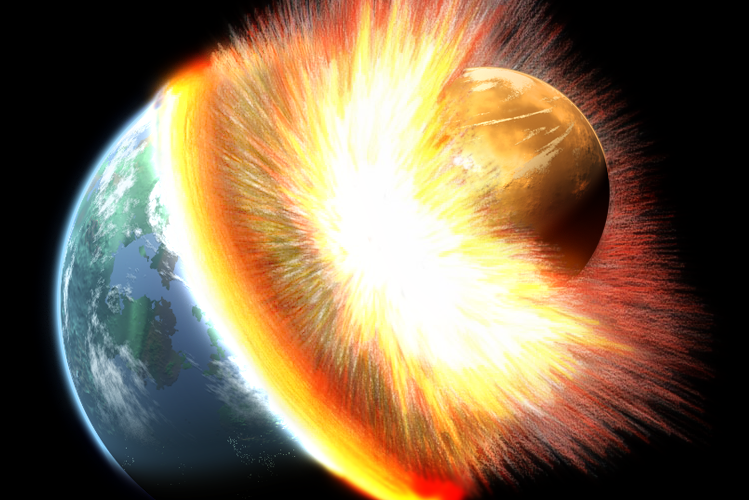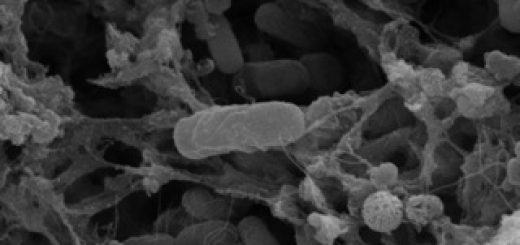How to Make a Moon

As the asteroid hurtles toward Earth at the end of the movie Armageddon when Bruce Willis makes the ultimate sacrifice for mankind, who knew that the writers of the film were in fact emulating real events. If you go back through history far enough to the very inception of our planet, the events of the infamous 1998 movie classic would seem trivial compared to the immense collision of Earth and Theia – a neighbouring planet over 6000 kilometres in diameter – from which our moon was created.
The story goes that a solitary early Earth orbited the sun happily until one day, 4.5 billion years ago, Theia swooped out of nowhere and collided with Earth, spraying debris out into the surrounding area; debris that later consolidated and formed our early moon. The impact may have been a glancing blow, however recent work suggests it was more liekly to be head-on, as the chemistry of the moon and Earth is almost identical, implying a complete merging of both early planets 1. This also explains both Earth’s slight tilt and why its core is larger than expected for a planetary object of its size; the head-on collision may have bumped the axis of Earth, creating our seasons, and Theia’s core may have mixed with Earth’s following the impact.
Though it sounds like the plot to a disaster movie, Theia’s impact with Earth is the leading theory. How the moon truly formed is still the centre of many an academic debate: Was it a passing asteroid caught up in earth’s gravity? Was it formed in unison from the same cosmic dust cloud? Did a rapidly spinning earth launch material into space that later became an orbiting satellite (an idea popularised by Charles Darwin’s son George). The further exploration of the moon by numerous upcoming launches (16 planned before 2020; hoping to obtain soil samples, water deposits and surface maps) may bring more evidence of the moon’s formation to light, potentially allowing us to establish whether Theia did in fact exist.
In addition to the work on the formation of our moon, new work has now also begun to unravel the mystery behind Mars’ two moons and their differing orbits. Phobos and Deimos, named after the Greek gods of fear and horror, are two of the smallest objects in our solar system. They orbit Mars at two very different distances (~9,000 kilometers and ~23,000 kilometers respectively), raising serious questions about their formation. Their size, density and composition are nearly identical to that of certain types of asteroid. This, plus the fact that Mars is located close to the asteroid belt, makes it probable that the moons are captured asteroids. However, several complex mechanisms must operate in unison to catch an asteroid and keep it in orbit aligned along an equator suggesting the capture of two asteroids by the gravity of Mars is highly speculative.
Recent work has supplied an alternative theory, which suggests that both moons are the result of yet another planetary impact 2. The theory states that Mars was also struck by an early planet, creating a vast disc of debris and material, much like the rings of Saturn. From these rings,one large moon and many other smaller objects formed before the former fell back to Mars, pulled in by the gravitational force of the planet. Evidence of this collision can be seen on the surface of the planet today as the extensive ‘Borealis Basin’, a vast depression in Mars’ northern hemisphere that covers up to a quarter of the planet’s surface. With the larger moon out of the way, Phobos and Deimos were all that was left orbiting Mars .
This new work not only furthers our understanding of early planetary collisions, but also builds upon our knowledge of how a planet’s gravity can affect the orbit of moons. It shows how the distance between a planet and its moon can either pull it inwards (Roche limit) or let it spin off into space (synchronous limit) meaning a moon must find the perfect balance between the two limits to form or face utter destruction. “[This work] shows a new possible outcome of the Giant [Impact] Scenario,” says Pascal Rosenblatt of the Royal Observatory of Belgium and lead author of the work. “the synchronous limit is well above the Roche limit [on Mars], preventing [it from maintaining] a massive moon in orbit.” These conclusions mean only smaller moons could survive in the orbit around Mars while much larger moons would always be drawn inwards.
Work like this continues to help us understand our solar system. “Their findings certainly help to explain some of the peculiarities of the Martian satellites,” says Martin Lee, a professor at the University of Glasgow, “but also provides motivation and scientific justification for further exploration of Phobos and Deimos.” And he is quite right; looking up at the stars and planets is intriguing to all of us, and with more work outlining the incredible circumstances that created them, who knows what continued investigation will uncover.
This article was specialist edited by Lisa Millar and copy edited by Matthew Hayhow.











do it now